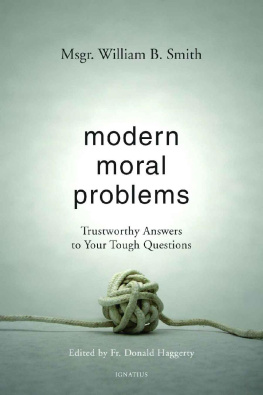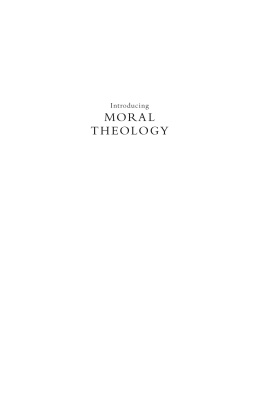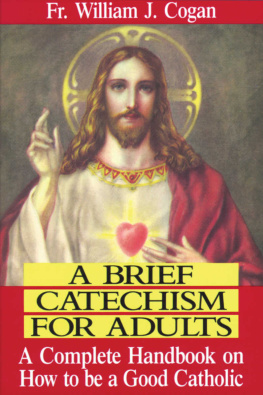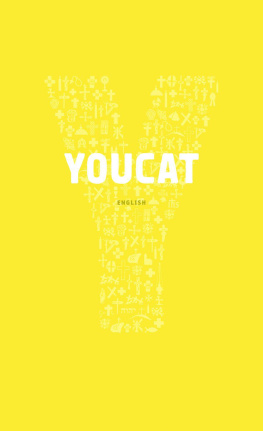Modern Moral Problems
Monsignor William Smith
MODERN MORAL PROBLEMS
Trustworthy Answers to Your Tough Questions
Edited by Father Donald Haggerty
IGNATIUS PRESS SAN FRANCISCO
Nihil obstat: Monsignor J. Warren Holleran
Imprimatur: Most Reverend George Niederauer
Apostolic Administrator
Archdioceses of San Francisco
Spetember 29, 2012
These questions and answers originally appeared in Homiletic and Pastoral Review . Reprinted with permission.
Unless otherwise noted, Scripture quotations (except those within citations) have been taken from the Revised Standard Version of the Holy Bible, Second Catholic Edition, 2006. The Revised Standard Version of the Holy Bible: the Old Testament, 1952, 2006; the Apocrypha, 1957, 2006; the New Testament, 1946, 2006; the Catholic Edition of the Old Testament, incorporating the Apocrypha, 1966, 2006, the Catholic Edition of the New Testament, 1965, 2006 by the Division of Christian Education of the National Council of the Churches of Christ in the United States of America. All rights reserved.
Excerpts from the English translation of the Catechism of the Catholic Church for use in the United States of America copyright 1994, United States Catholic Conference, Inc.Libreria Editrice Vaticana. English translation of the Catechism of the Catholic Church: Modifications from the Editio Typica copyright 1997, United States Catholic Conference, Inc.Libreria Editrice Vaticana.
Cover design by John Herreid
2012 by Ignatius Press, San Francisco
ISBN 978-1-58617-634-1
Library of Congress Control Number 2012933889
Printed in the United States of America
CONTENTS
ABBREVIATIONS
AAS Acta Apostolicae Sedis (Acts of the Apostolic See)
AOC NCCB, Always Our Children (October 1, 1997)
CCC Catechism of the Catholic Church
CDF Congregation for the Doctrine of the Faith
DS Denzinger-Schnmetzer, eds., Enchiridion Symbolorum
DV CDF, Donum Vitae (February 22, 1987)
ERDs NCCB, Ethical and Religious Directives for Catholic Health Care Services (1971, 1994, 2001)
EV Pope John Paul II, Evangelium Vitae (March 25, 1995)
FC Pope John Paul II, Familiaris Consortio (November 22, 1981)
GS Vatican Council II, Gaudium et Spes (1965)
HPR Homiletic and Pastoral Review
HV Pope Paul VI, Humanae Vitae (July 25, 1968)
IVF in vitro fertilization
NCCB National Conference of Catholic Bishops
PCHP CDF, On the Pastoral Care of Homosexual Persons (October 1, 1986)
ST Summa Theologiae
USCC United States Catholic Conference
USCCB United States Conference of Catholic Bishops
VS Pope John Paul II, Veritatis Splendor (August 6, 1993)
INTRODUCTION
Father Donald Haggerty
Monsignor William B. Smith (1939-2009) was a well-known and highly regarded moral theologian in the United States during the difficult decades of theological struggle in the Church following the Second Vatican Council. Ordained for the Archdiocese of New York in 1966, he was sent after a brief stint in parish work to the Catholic University of America, where he attended graduate classes taught by Father Charles Curran. By that time, Father Curran had achieved notoriety as a zealous organizer of public dissent against Pope Paul VIs encyclical Humanae Vitae condemning artificial birth control. Later, after a Vatican investigation in the 1980s, Curran lost his license to teach theology at any Catholic institution. Monsignor Smith liked to mention on occasion that Father Curran was a significant influence on his own thoughtprecisely to counter and refute aberrant positions in moral theology. After completing his doctoral studies, Monsignor Smith began a long career of thirty-seven years teaching at New Yorks major seminary until his untimely death in 2009. He taught continually there until the last weeks before his final illness.
During those years, he became a founding member of the Fellowship of Catholic Scholars, which was established in the 1970s for the mutual support and collaboration of scholars faithful to the Pope and the Magisterium. He worked extensively for the pro-life movement in the United States, giving countless talks all over the country and keeping the protection of human life a first-priority moral issue. He was a consultant to the Congregation for the Doctrine of the Faith (CDF) as well as a primary advisor on moral matters to Cardinals Cooke, OConnor, and Egan in New York. He served on ethics committees in a number of New York Catholic hospitals. He was a steady presence in a Westchester County parish on weekends, but he was also very close to Mother Teresa of Calcuttas Missionaries of Charity and to the Sisters of Life. He served as a weekly confessor and spiritual guide to the Missionaries of Charity for twenty-eight years; and at the personal request of Cardinal John OConnor, he gave weekly conferences in moral theology to the Sisters of Life for two decades.
While never writing a book, he published numerous articles in theological journals and established himself in the 1970s and 80s as a premier voice of Catholic faithfulness in the gritty arena of moral theology. His strong suit was an uncompromising fidelity to the Magisterium and to the Catholic moral tradition. His articles show a particular ability to measure the weight of tradition against more questionable, recent approaches to morality. In areas of medical ethics, for instance, he displayed expertise and great care, consistently basing his arguments on authoritative sources. His appeal as a writer, however, went beyond the clarity of his moral arguments. He wrote with verve and wit; he was neither timid nor tentative in exposing the foolishness of error. One might surmise that his writings were motivated by a profound sense of the harm done to lives when evil choices are rationalized.
The collection contained here is a selection of questions and answers submitted to Monsignor Smith and published in the monthly Homiletic and Pastoral Review between October 1992 and July 2005. The variety of questions and responses spreads far and wide over the course of these years. For the most part, the selections for this collection concentrate on questions of moral matters, with occasional items of sacramental interest. In many cases, the issues and responses are examples of what has been called in the moral tradition the exercise of casuistry. The term casuistry refers to the study of cases involving particular moral dilemmas that require resolution. At times, such matters are without a current clear teaching in the Church. The answers of Monsignor Smith are presented with careful awareness of distinctions and possible ambiguities. They display as well his zest and vigor for a lively rejoinder. These concise responses to still relevant moral questions are accessible to any informed Catholic today; undoubtedly, they will continue to interest new generations of priests. Even knowing an answer, one may find oneself enjoying Monsignor Smiths broad range of references and his pungent prose.
The encyclical Veritatis Splendor was issued on August 6, 1993, less than a year after Monsignor Smith began to write his monthly contributions to Homiletic and Pastoral Review . It was among the most notable writings in the pontificate of Pope John Paul II. Addressing fundamental principles of moral theology and the incompatibility of some contemporary moral approaches with Catholic theology, it applied a broadside blow to the dissenting moral theology that had gained much ground in the previous twenty-five years. The collection of these questions and answers can be read now as an expression of a more confident turn in moral theology that ensued in the years following Veritatis Splendor . Monsignor Smith and like-minded theologians found in the encyclical a vindication for a sound Thomistic foundation in the Catholic moral tradition. Many of the responses contained here make explicit use of principles found in the encyclical. The title of the encyclical, moreover, The Splendor of Truth , evokes the attractive radiance that truth offers to those who seek it with honesty. One can sense throughout the answers in this collection a profound respect for truth as an ultimate value.
Next page







